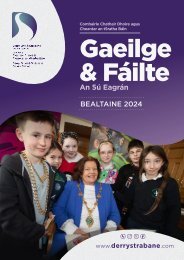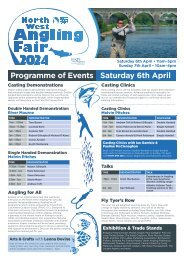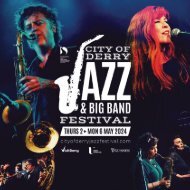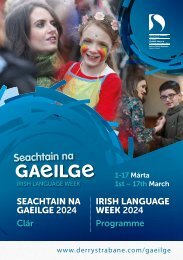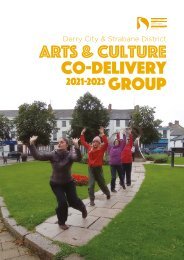Derry & Strabane: Natural Capital Report of Outdoor Recreation Spaces 2021
An analysis of the true social, health, economic and environmental value of green and blue spaces in our District using Natural Capital Accounting.
An analysis of the true social, health, economic and environmental value of green and blue spaces in our District using Natural Capital Accounting.
Create successful ePaper yourself
Turn your PDF publications into a flip-book with our unique Google optimized e-Paper software.
Discussion: Accessibility <strong>of</strong> greenspaces<br />
3<br />
Proximity is a key determinant <strong>of</strong> access to<br />
greenspaces and visit frequency. Analysis from<br />
the UK showed travel time to greenspaces<br />
determined the frequency <strong>of</strong> use by residents<br />
(Dallimer et al., 2014). In other regions, studies<br />
have found that proximity to green spaces also<br />
influences mode <strong>of</strong> travel, activity levels and<br />
overall health outcomes (Kaczynski et al., 2014;<br />
WHO, 2016).<br />
Access is typically measured in terms <strong>of</strong> walking<br />
time from home. Various countries have adopted<br />
linear distance targets as a baseline, ranging from<br />
300 metres to 1,000 metres (van den Bosch et al.,<br />
2016; Wustemann and Kalisch, 2016). For example,<br />
<strong>Natural</strong> England established an Accessible<br />
<strong>Natural</strong> Greenspace Standard, which categorises<br />
the types <strong>of</strong> spaces by their size and radius<br />
proximity from home, ranging from 2ha to 500ha<br />
(<strong>Natural</strong> England, 2010). This report examines<br />
the population within 200m, 300m, 400m, and<br />
1km from publicly managed and accessible<br />
greenspaces, for comparison to the 2019 NCA,<br />
for standardisation with the Accessible <strong>Natural</strong><br />
Greenspace Standard (300m), and to identify areas<br />
<strong>of</strong> low accessibility in urban regions.<br />
COVID-19 has underscored the importance <strong>of</strong><br />
easily accessible neighbourhood greenspace. As<br />
lockdowns and mobility restrictions have limited<br />
the use <strong>of</strong> public transport, in many communities,<br />
neighbourhood greenspaces are the only<br />
opportunity for safe socialisation, recreation and<br />
exercise. In the UK, the sharp disparities <strong>of</strong> access<br />
to greenspaces and the associated health benefits<br />
have been highlighted. Survey data in the UK<br />
reveals that lower income populations and ethnic<br />
minorities live further from greenspaces and<br />
gardens (Barkham, 2020). These same groups are<br />
disproportionately likely to face economic, social<br />
and health impacts <strong>of</strong> COVID-19, exacerbating<br />
inequalities.<br />
Figure 6 & Table 3 highlight that the majority<br />
<strong>of</strong> urban residents live in close proximity to<br />
greenspaces in <strong>Derry</strong> and <strong>Strabane</strong>. In urban areas,<br />
99% <strong>of</strong> residents in <strong>Derry</strong> and 97% in <strong>Strabane</strong><br />
are located within 1km from a publicly accessible<br />
greenspace. In the region as a whole, 63% <strong>of</strong><br />
residential dwellings in the District meet the<br />
Accessible <strong>Natural</strong> Greenspace Standard (ANGSt).<br />
The ANGSt threshold represents easily accessible<br />
greenspace and is measured as five minutes<br />
walking distance or approximately 300m.<br />
In urban areas, more than three-quarters <strong>of</strong> the<br />
population meet the ANGSt, while accessibility<br />
is lower in rural areas (Table 3). However, it is<br />
difficult to provide greenspace within a 300m<br />
radius for more sparsely populated rural settings<br />
and <strong>of</strong>ten inefficient to do so, since rural residents<br />
<strong>of</strong>ten have good access to private gardens or other<br />
opportunities for outdoor recreation.<br />
Table 3: The percentage <strong>of</strong> households within a radial distance <strong>of</strong> greenspaces<br />
REGION 200m 300m 400m 1km<br />
DERRY (URBAN) 65% 78% 86% 99%<br />
STRABANE (URBAN) 70% 77% 81% 97%<br />
RURAL 29% 37% 43% 68%<br />
ALL 53% 63% 70% 71%<br />
Source: Vivid Economics<br />
17







